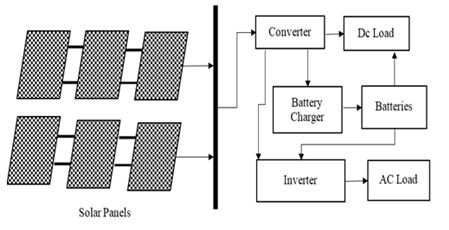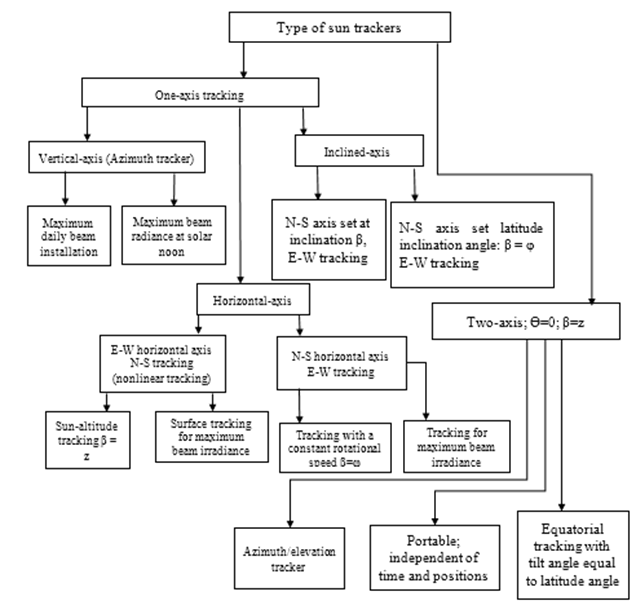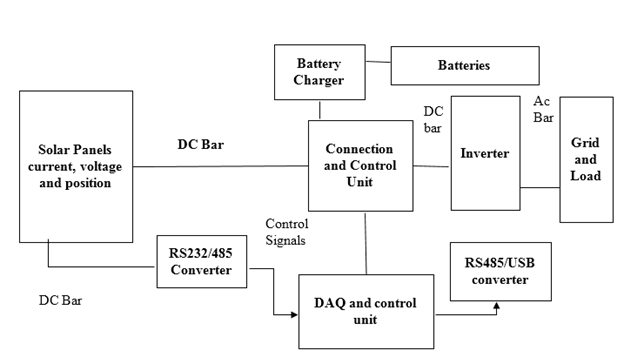Review Article, J Nucl Ene Sci Power Generat Technol Vol: 11 Issue: 4
Sun Tracking Solar Panels
Prasanna Mishra1*, Manoj Kumar Ojha2, Pooja Singh3 and Sakshi Singh4
1Department of Automoblie Engineering, PSG College of (Deemed-to-be University), Coimbatore, India
2Department of Physics, Sanskriti University, Mathura, Uttar Pradesh, India
3Department of Mechanical Engineering, Sanskriti University, Mathura, UttarPradesh
4Department of Physics, SGT University, Gurugram, Haryana
*Corresponding Author:Prasanna MishraDepartment of Automoblie Electronics and Communication Engineering, PSG College of (Deemed-to-be University), Coimbatore, India; E-mail: prasannamishra234@gmail.com
Received date: 03 November, 2021, Manuscript No. JNPGT-21-46553;
Editor assigned date: 05 November, 2021, PreQC No. JNPGT-21-46553 (PQ);
Reviewed date: 19 November, 2021, QC No. JNPGT-21-46553;
Revised date: 03 January 2022,Manuscript No. JNPGT-21-46553 (R);
Published date: 23 March 2022,DOI: 10.4172/2325-9809.1000265
Citation: Prasanna M, Manoj KO, Pooja S, Sakshi S (2022) Sun Tracking Solar Panels. J Nucl Ene Sci Power Generat Technol 11:4.
Abstract
One of the biggest challenges is look up for a source that will quench the thirst for ever-growing energy demands. This was achieved by employing photo-voltaic cells that can convert sun’s energy into electrical energy. A solar panel consist of a number of such cells. The designing and applications of an unorthodox single axis tracking system was developed that is capable of following the sun’s position. The tracking system has RS485 for serial communication and serve the purpose of intercommunication between monitor and rest of the system micro-controller will calculate the value of various parameter such as current, voltage and position angle. The solar energy collected is relatively very large as compared to fixed system. Various types of tracking system for the sun are discussed and compared.
Keywords: Solar energy, Unconventional energy resources, Single axis tracking, Programmable logic control, Azimuth angle
Introduction
In terms of generation of power, the sixth largest country in the world is India. For maintaining daily life and industries, the most important form is electrical energy among other forms of energy. Thermal plants contribute to more than sixty percent of generation of power, hydroelectric plant contribute to twenty-two percent, nuclear plants bestow around three percent and around ten percent is given by renewable energy resources such as wind, solar, biomass etc. Thus the country has invested a large amount in the unconventional energy resources. Till August 31st 2020, the installed capacity of solar plants generation in India is around thirty-five thousand seven hundred and forty megawatts. Because of continuous depletion of conventional energy resources and growing demand for un-conventional energy resources it is a need to shift to these resource for generation of power. Energy from sunlight can be directly converted to electrical energy with the help of solar cells. A module of solar cells will contain around forty to seventy cells and a number of such modules can be ascended on arrays which are called Photo-Voltaic (PV) arrays.
These cells can be of a few meters. Power of household and even for large electrical utility, a number of photo-voltaic arrays are capable enough to provide power. The power is stored in a solar cell in the form of direct current and converted into alternating current with the help of an inverter before connecting it into the power grid. In figure 1, block diagram of a solar system that is connected to grid is given [1]. The block diagram has modules of photo-voltaic cells, inverter, converter, battery charger, batteries and AC-DC loads. There are two ways in which these arrays can be set up, one is having a fixed angel that faces the south direction and the other is on a tracking system which is capable of following the rays of sun for maximum exposure. Efficiency of solar cell is defined as the ration of electrical energy produced to the energy of sun input to the cell. Since photo-voltaic systems require more installation cost and maintenance cost, the overall production of energy from these unconventional resources are costlier as compared to conventional energy resources. To increase the efficiency of solar cells, a tracking system is placed on the PV cells for reducing the overall cost of power generation.
| Parameters | Fixed | One-axis | Two-axes | Developed system |
|---|---|---|---|---|
| Installation | Easy | Easy | Difficult | Easy |
| mechanism | No mechanism | Simple | Complicated | Simple |
| Cost | Cheap | Moderate | Expensive | Moderate |
| Efficiency | Reference efficiency | 10-35% > fixed system | 25-45% greater than fixed system | 10-45% greater than fixed system |
| Design | Simple | Moderate | Complicated | Simple |
| Maintenance | Less | Moderate | More | Less |
Table 1: Comparison of various types off solar system.
In Table 1, comparison of various parameters like installation, level of mechanism, efficiency, cost, design and level of maintenance have been discussed. The fixed systems are of low-cost, simple, and the electromechanical setup is easier with very easier installation but the efficiency was also lower. The one-axis and two-axis systems are more efficient as compared to fixed system (Figure 2).
Literature Review
Authors Mohsen Taherbaneh, A. H. Rezaie, H. Ghafoorifard, K. Rahimi, and M. B. Menhaj have discussed about the three methods for maximizing the output power of the solar panel and the technique used was Fuzzy logic. The measured value came out to be 23 W and it is more than fifty percent of the formal output power. The second method had output of 11 W which is less than twenty-five percent of the nominal output power [2]. Author Ali Al-Mohamad has presented a design for tracking the sun in which the PLC unit will control the movement of the panel depending on the sun’s radiation. When compared to the fixed system, it was observed that the power output increased by more than 20 percent. It can be used as standalone device and also interconnected to computer device by employing a RS232 serial port for monitoring [3]. Authors A. Burgio, D. Menniti, A. Pinnarelli and N. Sorrentino presented a PV plant and a Wind plant which is integrated with an uninterrupted power supply for reducing the critical loads. The test of reliability was done on the basis of improvement of the UPS and supply continuous power to critical loads [4].
Authors Hossein Mousazadeh, Alireza Keyhani, Arzhang Javadi, Hossein Mobli, Karen Abrinia and Ahmad Sharifi have discussed the sources of energy and the growing demand in the world for energy. For meeting this challenge, the PV cells are used for meeting this demand. The radiation intensity is affected by the seasonal movement and earth’s movement. For compensating these motions, sun trackers are used that keep on changing the orientation of the panels [5]. Authors P. Roth, A. Georgiev, H. Boudinov have designed electromechanical system for following the position of sun at the Solar Evaluation laboratory of technical university. It could detect solar radiation automatically and is a closed loop system. The position of sun was sensed by a 4-quad photo detector and for the purpose of movement, direct current motor was used [6]. Authors Ibrahim Sefa, Mehmet Demirtas and Ilhami Çolak have introduce designing and application of single axis system for sun tracking and investigation of single axis of the tracking system was set up [1]. Author Cemil Sungur have carried out the study of solar and azimuth altitude angles of sun in northern hemisphere. Electromechanical system was set up for tracking the sun on bot h axes that is controlled with the help of a PLC [7].
In Figure 3, the block diagram of the system proposed is given. The system’s block diagram consists electro-mechanical parts, unit for acquisition of data and control unit, connection unit, control unit, inverter, modules of photo-voltaic, converter, battery charger, batteries, computer system and an AC load. The data is collected by a microcontroller which is done with the help of DAQ unit. The data is sent over to the computer system through serial connection with the help of RS48. The data is stored on RS 485 for the purpose of displaying in the computer system [8]. The software used is developed on C# language and it shows solar module’s panel’s positions automatically. The tracking system for sun is controlled by a direct current motor which will follow sun in day. Solar panels are mounted on this tracking system. Use of photo-voltaic cells is made for the production of energy electrical which is sent over to the DC bar. This direct current energy is stored in the batteries and further sent to loads as and when applicable. As soon as the batteries are fully charged to their capacity, the energy being produced further is sent over to the load directly or it can also be fed back to the grid via an inverter. In case, batteries are empty then the load requirement is met by the power grid. Thus, there is bidirectional flow of power from grid to the power station and vice-versa. Various components are discussed in details [1].
Electro-magnetic systemThe system has been designed and implemented for getting maximum value of electrical energy and also it is capable of running with the grip parallel. It has fourteen solar panels each of one hundred and eighty-five watts with total capacity of two thousand and five hundred watts. They weigh up to about 3600 kg. For the purpose of rotation, a direct current motor of 24 volts and 50 W has been used. There are two redactor having an angle of ninety degrees. The ratio of first redactor is 1/200 while that of second is 1/80. The mechanical power is sent to the first redactor and then sent over to the second redactor. This mechanism has been designed for proper motion of solar panels. Two photo resistors are employed for this purpose. These are connected in serial connection and are placed on the opposite sides of the pyramid. When the sensors are detecting equal sunrays, the voltages are equal on both sides and if there is any inequality the panels are moved for obtaining the position of equal voltages [9].
Measurement strategyFixed solar system and tracking solar system both have collected data and an analysis of data was done on the efficiency of both of these. The current, voltage, angle, and problems were monitored by the system and any warning system was sent. The program will wait for the wait time assigned. As soon as the wait time is over, solar system’s position is checked. If the condition is true, then the current, voltage and angle of the system was measured and stored in the database. The tracking system checks the condition for the true condition and whenever a false condition is there the movement of panel is carried till the true condition is achieved.
Software of the systemVisual C# language has been used for software for providing control. For the purpose of recording data, design of communication circuit has been done. The tracking system has interface for communication in which RS485 in used for monitoring voltage, current and position of panel. As soon as program starts controlling of communication is carried out. The connection of motor is checked in given steps: In case of any faults, the whole system is returned to the original condition. In case there is no fault control mode is chosen by the program. In the first mode, the value of current, voltage is displayed on the screen. The wait time is entered and then all the voltages are recorded in the database. The position of panel is checked for true value. If value is false, panel’s position is again checked and set to the exact value by the software [10].
Discussion
To carry out the experiment, latitude of 28.7041 north and 77.1025 east in degrees was selected which are coordinates of Delhi at 2 separate positions. For the 1st position, the panel has been mounted towards south facing a fixed position. For the second position, the mounting was done considering the fact that it needs to track sun every hour from sunrise to sunset. The output of the programming logic controller changes for every hour and panel of the photo-voltaic cells will track the sun with the help of an actuator motor. For every hour, current, voltage and power was measured for both the positions. The determining factors for the maximum power obtained is a function of the intensity of solar radiation, ambient temperature and various other features of the system. The Siemens EM232 module will do operations of twelve bit and resolution value is calculated when the numerical value to an analogue value that will cause an error signal. If the weather is cloudy, the photo sensors will have problem in detecting the location of the sun. For reducing this error, motor controls are installed and for this additional hardware is installed. The system developed needs no additional hardware.
Conclusion
The paper has described the designing and implementation for single-axis system for tracking depending on a computer system for controlling. This system had RS485 for the purpose of serial communication and a keeping an eye on the computer screen. Designing and testing of the system was carried out on two-thousand five hundred watts’ solar panels. Various parameters such as current, voltage and position of panel can be illustrated on and controlled via the computer. The sensor signals are recorded by a microcontroller unit which was interfaced with an analog to digital converter. This data is then sent to the computer by RS485 connection and then stored. Also the programming language C# for developing the program helps in displaying and controlling the data. The acquisition system has increased the size and cost, flexibility and usability is decreased. The overall weight of the electro-magnetic system is around three thousand five hundred kilograms has enabled the panels to be tilted at thirty-two degrees. The position of maximum energy occurred in both summer and winter for single axis system because of the variations in sun’s altitude. For future work, instead of the mono-crystalline conventional panels luminous solar panels can be used since they have the highest efficiency possible till date. If we calculate the transfer function, then efficiency can be increased and errors be reduced by making use of various controllers viz, PD, PID, ID etc. Also for better response and resolution, the digital control should be used.
References
- Sefa I, Demirtas M, Colak I (2009) Application of one-axis sun tracking system. Energy Convers Manag 50: 2709-2718.
- Taherbaneh M, Rezaie AH, Ghafoorifard H, Rahimi K, Menhaj MB, et al. (2010) Maximizing output power of a solar panel via combination of sun tracking and maximum power point tracking by fuzzy controllers. Int J Photoenergy.
- Al-Mohamad A (2004) Efficiency improvements of photo-voltaic panels using a Sun-tracking system. Appl Energy 79: 345-354.
- Burgio A, Menniti D, Pinnarelli A, Sorrentino N (2007) The reliability evaluation of a power system in presence of photovoltaic and wind power generation plants and UPS. IEEE.
- Mousazadeh H, Keyhani A, Javadi A, Mobli H, Abrinia K, et al. (2009) A review of principle and sun-tracking methods for maximizing solar systems output. Renew Sustain Energy Rev 13: 1800-1801.
- Roth P, Georgiev A, Boudinov H (2004) Design and Construction of A System For Sun-Tracking. Renew energy 29: 393-402.
- Sungur C (2009) Multi-axes sun-tracking system with PLC control for photovoltaic panels in Turkey. Renew Energy 34: 1119-1125.
- Asiabanpour B, Almusaied Z, Aslan S, Mitchell M, Leake E, et al. (2017) Fixed versus sun tracking solar panels: an economic analysis. Clean Technol Environ Policy 19: 1195-1203.
- Mousazadeh H, Keyhani A, Javadi A, Mobli H, Abrinia K, et al. (2009) A review of principle and sun-tracking methods for maximizing solar systems output. Renew Sustain Energy Rev 13:1800-1801.
 Spanish
Spanish  Chinese
Chinese  Russian
Russian  German
German  French
French  Japanese
Japanese  Portuguese
Portuguese  Hindi
Hindi 




